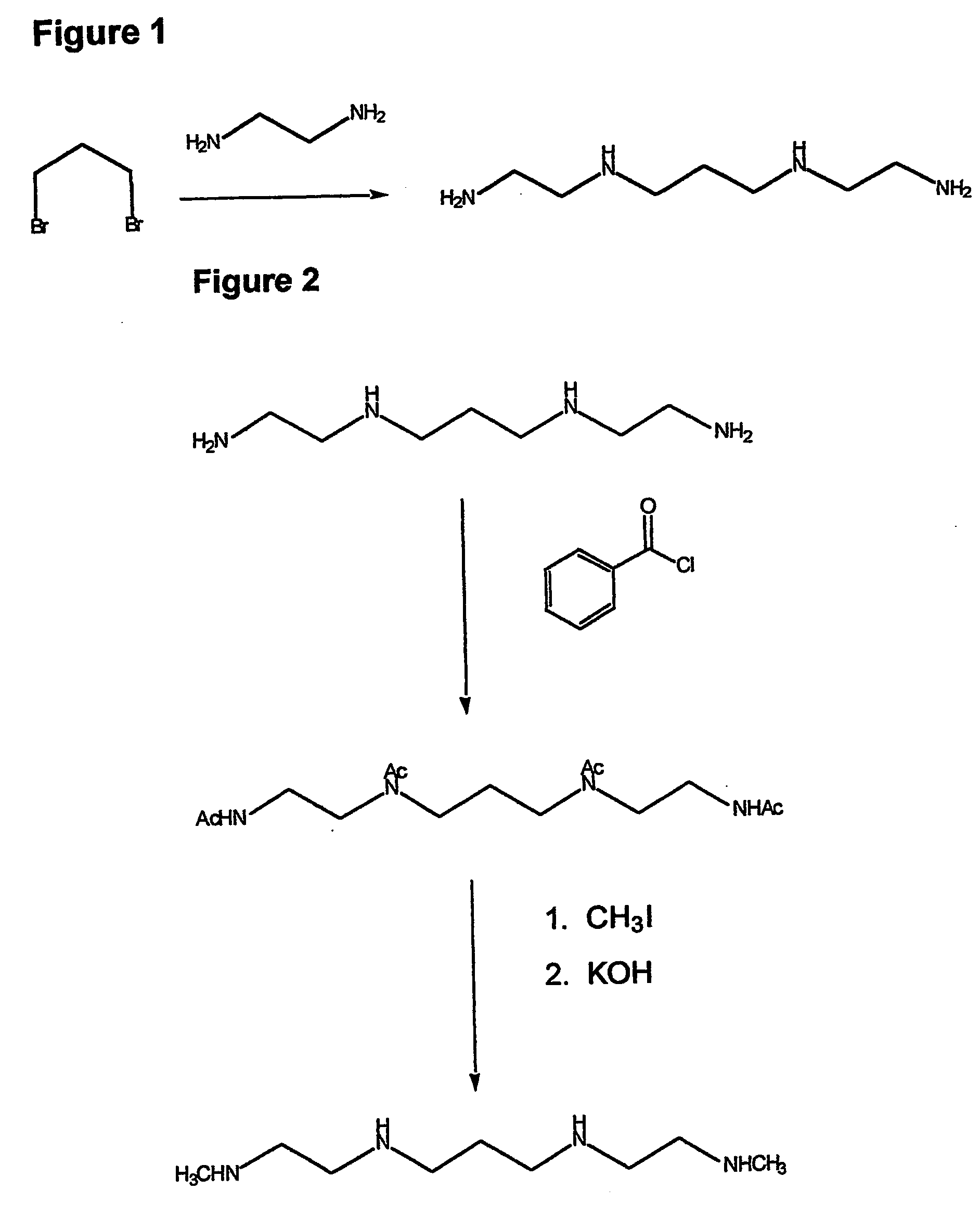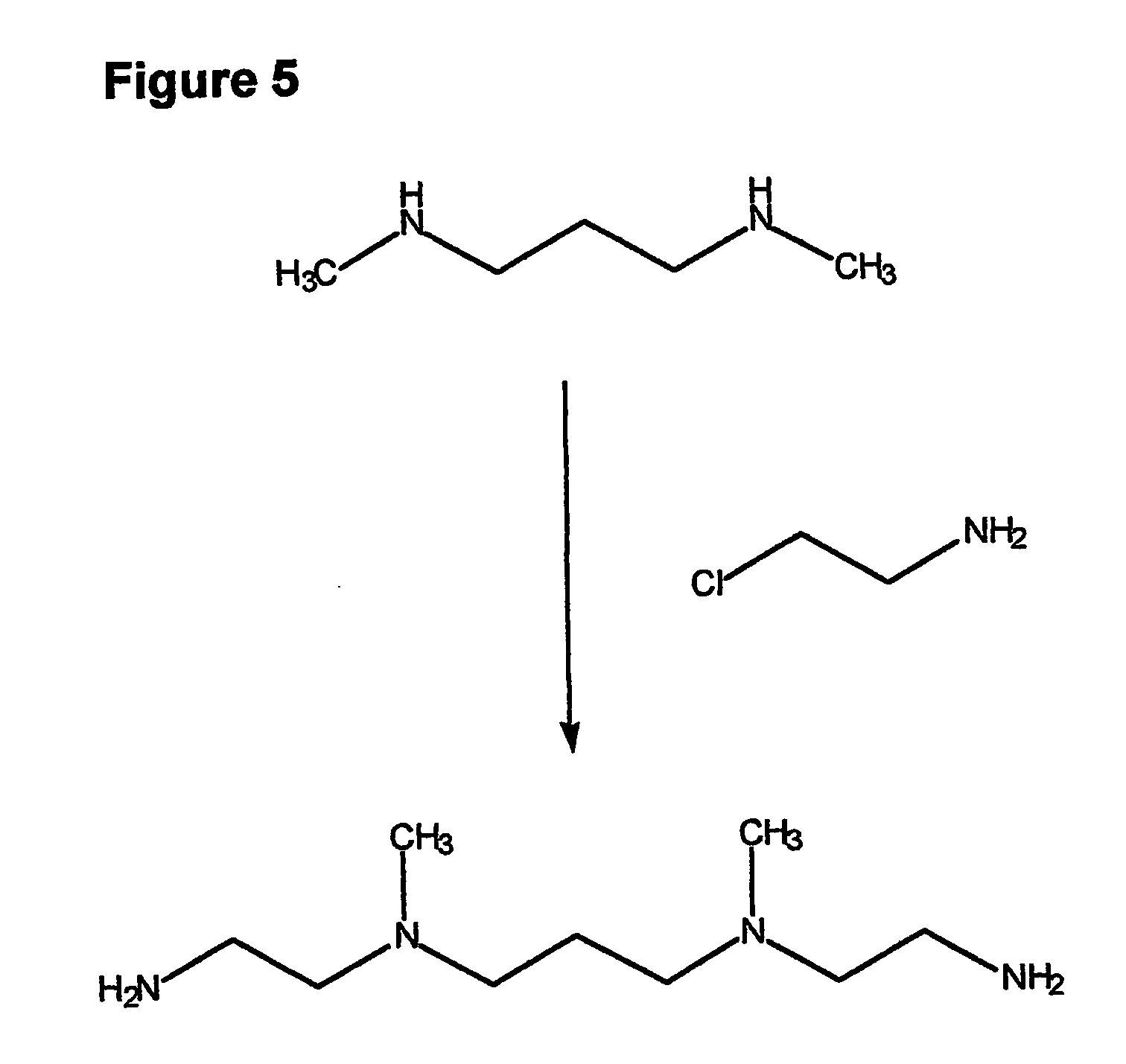Composition, synthesis and therapeutic applications of polyamines
a technology of polyamines and amines, applied in the field of polyamine composition, synthesis and therapeutic applications, can solve the problems of reducing mitochondrial transportation and axonal transportation, oxidative phosphorylation, and cellular damage, and achieves reduced hepatic chromium concentration, reduced aortic chromium concentration, and increased chromium excretion by the kidney
- Summary
- Abstract
- Description
- Claims
- Application Information
AI Technical Summary
Benefits of technology
Problems solved by technology
Method used
Image
Examples
example 1
1,3bis-[(2′-aminoethyl)-amino]propane [FIG. 1]
[0228] A mixture of 15 g of 1,3-dibromopropane and 50 mL of absolute EtOH was added slowly to 25 g of 1,2 diaminoethane hydrate. The mixture immediately became warm. It was then heated to 500C for 1 hour, 20 g of KCl added and the heating continued for 30 minutes. The mixture was filtered from the KBr and distilled at reduced pressure. The residue formed two layers that were separated. The top layer was distilled and the product had a b.p. of 115-116° C., (1 mm). The compound was further purified by converting the free amine to its tetrahydrochloride salt by addition of 6M. HCl. The melting point of the salt was 278-283° C. It was converted back to its free amine by treatment with NH4OH. Mass spectral analysis showed a m / e=160. 1H NMR (CDCl3): δ 1.26 (6H, s), 1.60 (2H, quin), 2.60 (4H, t), 2.71 (8H, t).
example 2
[12(methylethylamino)ethyl](3-[(methylamino)ethyl]amino)propyl)amine [FIG. 2]
[0229] A mixture of 0.37 g (0.0155 mol) of magnesium turnings, 5.0 g (0.031 mol) of 1,3-bis-[(2′-aminoethyl)-amino]propane, 50 mL of benzene and 3.76 g (0.047 mol) of acetyl chloride is heated under reflux for 2 h. The reaction mixture is cooled in an ice bath and the liquid portion is decanted into a separatory funnel. The residue in the flask is washed twice with 50 mL portions of ether, and the ethereal solution is poured over ice. The ether-water mixture is then added to the benzene solution in the separatory funnel and separated. The organic phase is washed once with 50 mL of 5% sodium bicarbonate and once with water and dried over CaCl2. The solution is filtered and used without further purification.
[0230] A magnetically stirred mixture of 5.0 g (8.67 mmol) of the acetylated 2,3,2-tetramine prepared above and 2.0 g (80.7 mmol) of sodium hydride in 75 mL of N,N-dimethylformamide was heated at 60° C. u...
example 3
(2-piperidylethyl)-(3-[(2-piperidylethyl)amino]propyl}amine [FIG. 3]
[0232] To a mixture of 0.5 g (6.75 mmol) of 1,3-diaminopropane and 50 mL of absolute EtOH was added 1.62 g (40.5 mmol) of NaOH To this solution was added dropwise 2.48 g (13.45 mmol) of 1-(2-chloroethyl)piperidine in 50 mL of EtOH over 30 min. The solution was allowed to stir for 24 h The solvent was evaporated and the residue was extracted with 2×50 mL of CH2Cl2, dried over Na2SO4, and evaporated to dryness. The compound was purified by converting it to its hydrochloride salt by addition of HCl. The melting point of the salt was >300° C. It was converted back to its free amine by treatment with NH4OH. The resultant oil (1.04 g, 52%) was analyzed. Mass spectral analysis showed a m / e=297 (M+1). 1H NMR (CDCl3): δ 1.40-1.82 (14H, m), 2.40-2.58 (14H, quin), 2.60-2.72 (10H, m).
PUM
| Property | Measurement | Unit |
|---|---|---|
| half life | aaaaa | aaaaa |
| half life | aaaaa | aaaaa |
| particle size | aaaaa | aaaaa |
Abstract
Description
Claims
Application Information
 Login to View More
Login to View More - R&D
- Intellectual Property
- Life Sciences
- Materials
- Tech Scout
- Unparalleled Data Quality
- Higher Quality Content
- 60% Fewer Hallucinations
Browse by: Latest US Patents, China's latest patents, Technical Efficacy Thesaurus, Application Domain, Technology Topic, Popular Technical Reports.
© 2025 PatSnap. All rights reserved.Legal|Privacy policy|Modern Slavery Act Transparency Statement|Sitemap|About US| Contact US: help@patsnap.com



